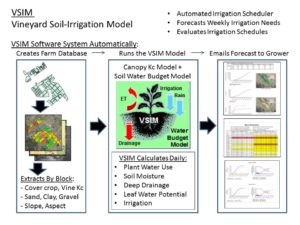2015:
Pruning for Winegrape Quality
Speaker: Chris Bowland, vineyard manager, Williams Selyem
Wednesday, November 4 at 3:00pm at Equinox 334 Ingalls St., Santa Cruz
Chris Bowland will share some of what he has learned about growing premium winegrapes in the Russian River over the past 16 years, including: pruning to avoid disease or to revitalize diseased vines; pruning styles including changing vineyards between cordon and cane; when best to prune; and pruning to maintain healthy vines.
About Chris Bowland: Chris and his wife Tanya are the proprietors of Bowland Vineyard Management, managing the Estate vineyards for Williams Selyem as well as many of the winery’s grower’s vineyards. Chris planted the first vineyard blocks at Willoiams Selyem’s Litton Estate in 2002 and has been instrumental in continuing the winery’s brand and reputation for Pinot Noir excellence. Bowland Vineyard Management oversees about 400 acres in the Russian River and Bennett Valley AVAs. Chris’ strength in the vineyards comes from an extensive background in both farming and agriculture, and an innate ability to draw from both philosophies as vineyard situations demand. Chris is a legendary fisherman in his limited free time, enjoying casts off the local riverbanks of the North Coast. You can see more about Chris on the Williams Selyem website here.
New Perspectives and Tools for Vine Water Use and Saving Water – June 30
A Joint program with Community Alliance of Family Farmers (CAFF)
- Speakers include:- Tom Shapland, Tule Technologies. Tom spoke to us a year ago and is returning with an update. Tule has recently installed sensors measuring vine water status in several vineyards in the Santa Cruz Mountains (Ridge, Muns, Windy Oaks) and is now able to talk about the results they are measuring in our region. This presentation will address different seasonal stress targets for different production goals (for example, quality vs yield), as well as the stress levels and irrigation amounts on different soil types in Santa Cruz and other coastal regions.
– Lars Pierce with CSU Monterey Bay: The Vineyard Soil Irrigation Model (VSIM) provides free, automated irrigation forecasts.The VSIM model couples a canopy ETc model to a soil water balance model to estimate daily block water balances. For each day from Jan. 1, vine and cover crop water use (ETc) are calculated as the product of ETo and the crop coefficient (Kc). We then subtract ETc from soil moisture (SMy) and add in rainfall (R) and irrigation (I) to estimate the current soil moisture (SMd). When estimated soil moisture exceeds field capacity (FC), excess water is subtracted from soil moisture to estimate deep drainage (D). From soil moisture we estimate leaf water potential (LWP). As water stress increases, we reduce daily ETc using a Ks scalar designed to estimate the effects of water stress on stomatal closure. For more information, see the website at https://sites.google.com/a/csumb.edu/vsim/.

– Rich Casale, NRCS: ‘The Forgotten Practices’ That Help Save Water in The Vineyard
Many if not most water conservation efforts and programs concentrate on irrigation practices, improving irrigation system efficiencies, system conversions and all sorts of water management and monitoring methods. There are, however, many other practices (often overlooked) that can help reduce irrigation water use and/or save water.
Vineyard Microclimates: Sunlight Exposure, Grape Temperatures – May 27 at Cooper-Garrod 2:30 – 6:00.
Our guest speaker: Stuart Weiss, Ph.D. of Viticision will speak about making adjustments in the vineyard (to row orientation, canopy management) for improved grape quality, and how our vineyards may be affected and adapted in the face of changing climate. As well, we will get a tour of the certified organic vineyard and sustainable practices at Cooper-Garrod.
Sunlight and temperature are two of the most important factors that affect photosynthesis and ripening. Dr. Weiss will talk about how vineyard practices affect climates in the vineyard, and how to adapt practices to produce the highest quality grapes. Viticision’s climate analysis modeling tools help to determine optimal row direction and trellis design for the site based on balancing the light and heat environment to help reduce sunburn, improve ripening and grape quality.
Dr. Stuart Weiss is a climatologist and conservation biologiest in Menlo Park with a PhD in Ecology and Evolution from Stanford University. He focuses on the ecological effects of microclimate, weather and global warming – and brings this expertise to the vineyard with his company Viticision. Clients include J Lohr, Laetitia, Robert Mondavi, Chandon, and more.
Tailgate at Storrs Vineyards, Corralitos, Saturday May 9, 10:00-12:00.
Learn about the sustainable practices implemented at Storrs vineyards with a tour led by Steve and Pamela Storrs and Rich Casale of the NRCS. These practices include: drainage/runoff control, hedgerows, sheep grazing, wildlife-friendly practices including wildlife corridors and structures, rainwater harvesting; and other vineyard management and conservation practices, many designed and financed through the NRCS’ EQIP program.
